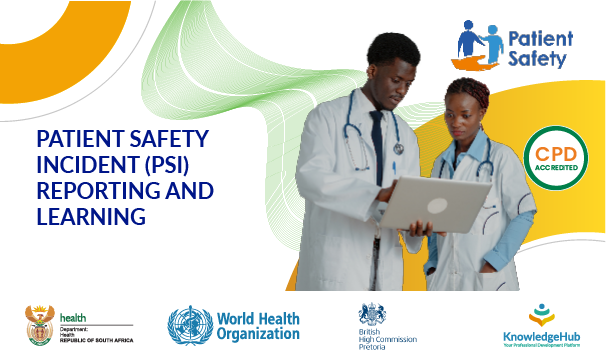Patient Safety Incident (PSI) Reporting and Learning Course
The National Patient Safety Incidents (PSI) reporting and learning guideline was published in 2017 and came into effect on 1 April 2018 and was revised in 2021 with implementation on 1 April 2022. The training module covers the content of the National PSI reporting and learning guideline and outlines the procedure to follow to manage PSIs and learn from errors to prevent reoccurrence.
The overall objective of the guideline is to provide direction to the public health sector of South Africa regarding the management of Patient Safety Incident (PSI) reporting, give guidance on appropriate feedback to patients, families/support persons and clinicians, and to share lessons learned to prevent reoccurrence of patient harm.
The key objectives are to cover the following:
- Purpose and objectives
- Legal and policy framework
- Scope
- Definitions
- Mandatory requirements
- PSI committees
- Minimum information model
- Steps to manage PSI
- Practical examples and explanations for classifications of PSIs
- How to reduce errors
- Monitoring and compliance
Device (cellphone, tablet, laptop, and/or desktop).
Accessing the course materials and recorded lectures online is free as the Knowledge Hub has been zero rated. An initial internet connection is required to connect to the KH.
The course has 4 modules as follows:
Module 1: Introduction and general overview
- Why is patient harm a global priority?
- Why develop a national PSI reporting and learning systems
- Revision of the guideline
- Purpose and objectives
- Legal and policy framework
- Scope
- Mandatory requirements
- Definitions
- What is reported?
- Steps to manage PSIs
- Progress made since implementation
Module 2 - Part 1: Management of PSI: Step 1 to 5
- Step 1: Identifying PSIs
- Step 2: Immediate action taken
- Step 3: Prioritisations
- Step 4: Notification
- Step 5: Investigation (including RCA)
Module 2 - Part 2: Management of PSI: Step 6 to 9
- Step 6: Classification
- Step 7: Analysis
- Step 8: Implementation of recommendations
- Step 9: Learning
Module 3 - Part 1: PSI classifications, examples, and explanations: PSI Type
- Practical examples and explanations provided for the sub-classification for incident types
Module 3 - Part 2: PSI classifications, examples, and explanations: Contributing factors and outcomes
- Practical examples and explanations provided for the sub-classification for contributing factors and the main classifications for patient and organisational outcome
Module 4: Implementation, reporting and learning
- Implementation through Patient Safety Committees
- How can we create an environment that encourages PSI reporting?
- How to minimize errors?
- Monitoring and compliance
- Web-based information system
- How to obtain access
- PSI capture form
- Reports
- Dashboards
until
31 December 2023 - 12:00 am

